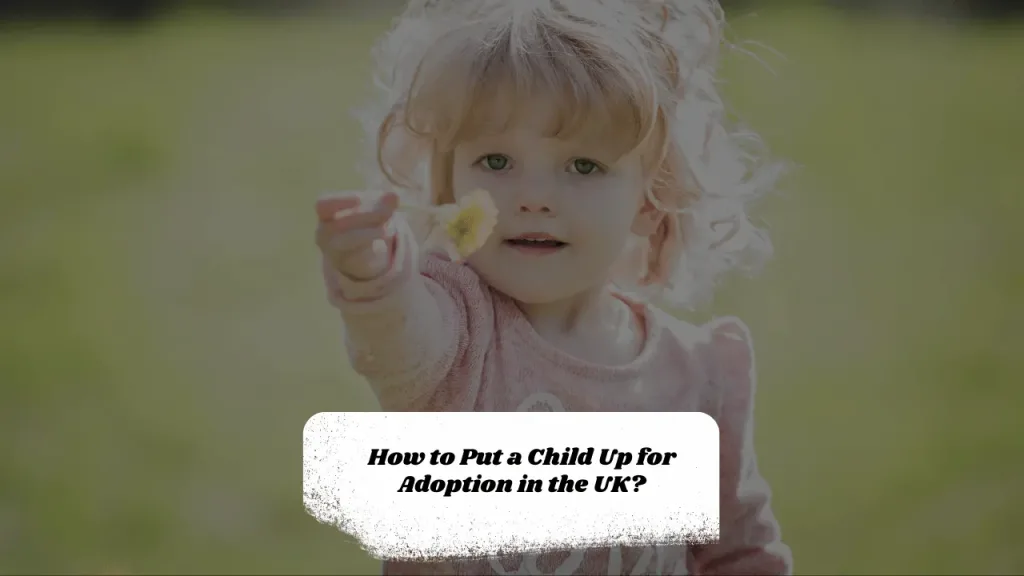How to Put a Child Up for Adoption in the UK?
Placing a child for adoption is a significant and emotional decision that requires careful consideration of legal, emotional, and practical factors. In the UK, the adoption process ensures that children are placed in loving and secure homes while protecting the rights of birth parents. This guide outlines the steps, legal requirements, and key considerations involved in putting a child up for adoption in the UK.
Table of Contents
What is Adoption?
Adoption is the legal process through which parental rights are transferred from the birth parents to adoptive parents. Once the adoption is finalized, the adoptive parents assume all legal responsibilities for the child, and the birth parents no longer have any legal rights or obligations toward the child. This process ensures that the child is cared for in a permanent, stable, and nurturing environment.
Steps to Put a Child Up for Adoption
Step 1: Contact an Adoption Agency or Local Authority
The first step in the adoption process is to contact an adoption agency or local authority. Adoption agencies in the UK are responsible for managing the adoption process and finding suitable adoptive families for children. You can reach out to a local authority or an independent adoption agency to discuss your options and receive guidance on the next steps.
Step 2: Assessing the Child’s Needs
A social worker will assess the child’s needs, taking into account their age, health, and any special needs they may have. The social worker will also consider the child’s background and emotional needs to ensure they are placed with the right adoptive family.
Step 3: Giving Parental Consent
For adoption to proceed, the birth parents must give written consent. However, parental consent can only be given after the child has been born for at least six weeks. Consent is voluntary, and parents have the right to withdraw their consent within 28 days of giving it. After this 28-day period, consent is considered final.
If the birth parent is unable to give consent due to mental incapacity or age, the local authority can apply for a Placement Order from the court, which would allow the child to be placed for adoption without the parent’s consent.
Step 4: Matching the Child with Adoptive Parents
Once the child is ready for adoption, the adoption agency will begin searching for adoptive parents. The matching process takes into account the child’s specific needs, such as their cultural background, medical history, and any other factors that may affect their wellbeing. The goal is to find a family that can offer the child a stable and loving environment.
Step 5: Placing the Child with Adoptive Parents
Once a suitable match is found, the child is placed with the adoptive parents. This placement is typically done on a temporary basis, during which the agency monitors the child’s adjustment to the new home. Social workers visit regularly to ensure that the adoption placement is in the child’s best interests.
Step 6: Finalizing the Adoption
After the probationary period, the adoption process moves to the final stage, where the Adoption Order is granted by the court. The Adoption Order permanently transfers parental responsibility to the adoptive parents, legally formalizing the adoption and severing the birth parents’ legal ties to the child.
Related Articles For You:
Who Has Custody of a Child Born Out of Wedlock in Indiana?

Legal Guidelines for Adoption in the UK
The adoption process in the UK is regulated by several laws:
- Adoption and Children Act 2002: This law governs the adoption process in England and Wales. It focuses on the child’s welfare as the paramount consideration in adoption proceedings.
- Children Act 1989: This Act ensures that the child’s welfare is at the heart of all decisions concerning their care, including adoption.
- Adoption (Intercountry) Act 1999: This law regulates the adoption of children from other countries, ensuring that UK adoption standards are met for international adoptions.
FAQs About Putting a Child Up for Adoption
Can I change my mind after agreeing to adoption?
Yes, birth parents can change their mind during the 28-day period after giving consent. After this period, consent is legally binding, and the adoption process continues.
Can I stay in contact with my child after adoption?
It depends on the type of adoption. Some adoptions are open adoptions, where the birth parents and adoptive parents maintain some form of contact or communication. This arrangement can be discussed with the adoption agency.
What if the father does not agree to the adoption?
If the father has parental responsibility, his consent is required for the adoption. If he refuses to consent, the adoption agency may apply for a Placement Order from the court, which allows the child to be placed for adoption without his consent.
What support is available for birth parents?
Adoption agencies provide emotional support, counseling, and advice for birth parents considering adoption. They can also guide parents through the legal process and help them understand their rights and options.
How long does the adoption process take?
The process can take several months, typically around six to twelve months, depending on the child’s situation and the availability of suitable adoptive parents.
Conclusion
Placing a child for adoption is a significant decision that requires careful thought and consideration. In the UK, adoption is a legal process designed to prioritize the welfare of the child. Birth parents have the right to give or withdraw consent for adoption, and the process involves careful matching with adoptive families, ensuring the best possible outcome for the child.
If you are considering adoption, it is important to investigate guidance from a reputable adoption agency or local authority. These professionals can help you learn the process and provide the support you need during this difficult time.
About the Author

Sarah Klein, JD, is a former family law attorney with over a decade of courtroom and mediation experience. She has represented clients in divorce, custody cases, adoption, Alimony, and domestic violence cases across multiple U.S. jurisdictions.
At All About Lawyer, Sarah now uses her deep legal background to create easy-to-understand guides that help families navigate the legal system with clarity and confidence.
Every article is based on her real-world legal experience and reviewed to reflect current laws.
Read more about Sarah
